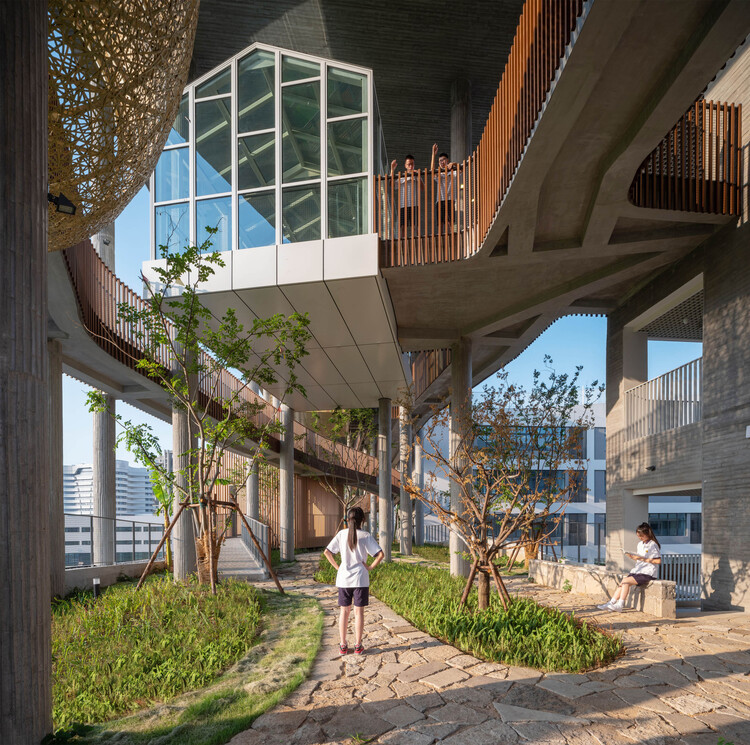
The World Architecture Festival announced the ultimate accolades of World Building of the Year, World Interior of the Year, Future Project of the Year and Landscape of the Year. A host of Special Prizes, including the International Building Beauty Prize, Best Use of Colour Prize and Small Project of the Year were also announced at the closing event, to celebrate the sixteenth edition of the festival. The announcement follows the final day of WAF, in which prize winners across all 44 categories competed for the winning titles.
WINNERS
World Building of the Year

World Building of the Year was awarded to Huizhen High School by Approach Design Studio/Zhejiang University of Technology Engineering Design Group in China. The project was initially shortlisted in the Completed Building School category.

Located in Jiangbei District, Ningbo City, Huizhen is a bold exploration of ‘efficiency-first’ campus design where time can be ‘wasted’ seriously. The boarding school campus is a ‘floating forest’ with classrooms hung in each corner of the forest and joined by meandering paths. Scattered tree houses provide students with temporary escapes from the burden of school. A ramp leads up to a gentle sloping roof, which doubles as an open-air lecture hall and a rooftop park with sporting facilities, usable by the public at the weekend – creating a new typology of architectural promenade.

World Interior of the Year
World Interior of the Year was awarded to 19 Waterloo Street by SJB in Australia. Originally shortlisted in the Residential (Single Dwelling) Category, the winning interior utilises expanded connections creatively within a limited footprint to create an open and quiet oasis in the city.

Wedged onto a narrow strip adjacent to the road, judges described this small multi-storey house as “like a wardrobe for the architect himself to live in”.
From the street the facade is punched with a random set of openings, but once inside, these reveal a highly tuned stack of rooms. Judges felt that “these generated a satisfying alignment and play of light”. There are unique furniture pieces and a work of art that was commissioned as a catalyst for the project. Craft and detail are everywhere, partly as a result of using materials salvaged from other projects. Judges described this winning interior project as “not only a building or an interior, but a pocket-sized tour de force”.

The winner was selected by a super jury of global design experts – comprising Nigel Coates, Nigel Coates Studio; Mark Dytham, Klein Dytham Architects; Ingrid van der Heijden, Civic architects; Friedrich Ludewig, ACME and Anna Xu, Dyson.
Future Project of the Year
Future Project of the Year went to The Probiotic Tower by Design and More International in Egypt. The project was initially selected from the Experimental category.

The Probiotic Tower’s central proposition is to repurpose obsolete water towers to positively address climate change as an adaptive system for cities, particularly in the developing world. At the core of the Probiotic Tower is a large algae bioreactor tank that absorbs CO2 from local sources. The building is expanded by establishing a bamboo plantation on-site and creating a amboo Cross Laminated Timber Production facility that grows modular components to build a supportive scaffold around the tower. Other features to promote the absorption of CO2 include facade algae panels, reed beds for treating wastewater and photovoltaic panels.

The winner was selected by a super jury of global architecture practitioners and academics – comprising Diogo Burnay, Dalhousie University; Issa Diabate, Koffi & Diabaté; Richard Maimon, KieranTimberlake and Tracy Meller, RSHP.
Landscape of the Year
Landscape of the Year went to Benjakitti Forest Park: Transforming a Brownfield into an Urban Ecological Sanctuary by TURENSCAPE, Arsomsilp Community and Environmental Architect in Thailand.

The winning Landscape project transforms a former tobacco factory into a resilient living ecosystem, which is now the largest public recreational space in downtown Bangkok. The project reduces the destructive force of stormwater, filters contaminated water, and provides much-needed wildlife habitat in a region experiencing monsoon climates with an average yearly precipitation of about 1500mm.
The winner was selected by a super jury of global landscape specialists and academics – Lily Jencks, LilyJencksStudio; Henry Steed, ICN Design International; Professor Rafiq Azam, SHATOTTO architecture for green living and Zhengxu Zhou, Tsinghua University.

Rifle Range Nature Park by Henning Larsen in Singapore, Boca de la Mina Promenade in Reus by Batlleiroig Arquitectura in Spain and Mayfield Park by Studio Egret West in the United Kingdom were also highly commended in the Landscape category.













